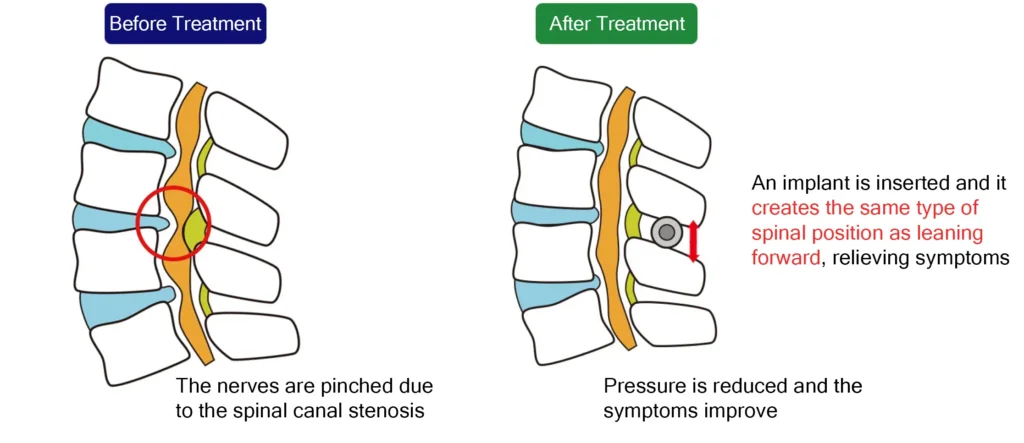Column Spinal Canal Stenosis, Progression and Symptoms: Of the Importance of Early Detection
May 30, 2025
The narrowing of the nerve pathways (i.e., the spinal canal) in the spine is called spinal canal stenosis.
In this article, we will discuss the symptoms associated with lumbar spinal canal stenosis.
The symptoms of spinal canal stenosis
The main symptoms of spinal canal stenosis are back pain and pain and numbness in the lower limbs.
Early Symptoms
In the early stages, usually only lower back pain will occur.
The symptoms in the lower limbs for spinal canal stenosis include pain and numbness that extend from the lower back to the buttocks, thighs, calves, and feet, and tend to be easily aggravated by prolonged standing or walking.
Advanced symptoms
Among the characteristic symptoms of lumbar spinal canal stenosis is intermittent claudication (a condition in which the patient feels pain or numbness in the legs when walking and must stop walking as a result, but after a short rest, they will feel better and can resume walking, only to have the pain return after a short time), which occurs when the stenosis has progressed.

The more advanced the symptoms of spinal canal stenosis, the shorter amount of time one can walk.
The inability to walk in turn decreases blood circulation to the legs, causing them to swell and feel heavy, and causes a significant loss of muscle strength.
In severe cases of spinal canal stenosis, bladder and bowel functions may also be affected, resulting in urinary and stool disorders.
In addition, if the patient becomes confined to bed, he or she often suffers from a loss of appetite, which can result in malnutrition and progressive muscle and bone breakdown.
Early diagnosis of spinal canal stenosis is critical.
Lumbar spinal canal stenosis is a prevalent condition in the elderly population.
Symptoms such as intermittent claudication make walking difficult and interfere with daily life. Some patients may never leave the house and become bedridden, and many become depressed as a result.
In addition, the more advanced the symptoms become, the less indicated a surgical procedure performed under general anesthesia, in which the spine is shaved off and maintained in place with metal plates, will become.
It is very essential to get an accurate diagnosis and appropriate treatment before the symptoms become too severe.
Treatments available for spinal canal stenosis
Surgical procedures: lumbar laminectomy and lumbar fusion
Although lumbar spinal stenosis may be treated with blocked injections, most cases are usually treated surgically.
The most common surgical procedures for spinal canal stenosis are lumbar laminectomy and lumbar fusion.
Lumbar laminectomy is performed under general anesthesia while using an endoscope, and the skin of the back is cut open and part of the vertebral arch and thickened ligamentum flavum is removed to relieve the pressure on the nerves and widen the spinal canal.
Lumbar fusion is performed under general anesthesia by making an incision in the skin of the back, removing the degenerated disc, and placing a cage filled with bone matter obtained from the hip bone to hold the vertebrae in place with screws and rods. It may be performed after a lumbar laminectomy.

Minimally invasive procedures: the Florence and Q-Florence methods
The Florence and Q-Florence methods are also used to treat spinal canal stenosis.
The Florence and Q-Florence procedures are minimally invasive, low-risk treatments for spinal canal stenosis.
Under partial anesthesia and sedation, a device is percutaneously inserted to widen the narrowed spinal canal.
The device is inserted to stabilize the vertebral body while preserving the patient’s spinal rotation and flexion, widening the spinal canal and reducing disc protrusion and ligamentum flavum thickening. Pain is eliminated by widening the narrowed spinal canal.

The Q-Florence Method (page in Japanese)
If you have been diagnosed with spinal canal stenosis and are suffering from back pain or intermittent claudication, please consider a consultation at our clinic.
Related Articles
Lumbar Spinal Canal Stenosis: Just What is Actually Happening to my Body?
The Different Symptoms of Spinal Canal Stenosis: If You Have Any of These, it’s a Red Flag!
What are the Various Complications Possible With Spinal Stenosis?
Why Do the Symptoms of Spinal Stenosis Differ From Person to Person?
Diagnosis and Treatment of Spinal Stenosis: Why Early Detection is Critical
How to Prevent Spinal Canal Stenosis: Things to Implement in Your Daily Activity Routine
Treatment of Spinal Canal Stenosis: A Comparison Between Surgery and Conservative Therapy



